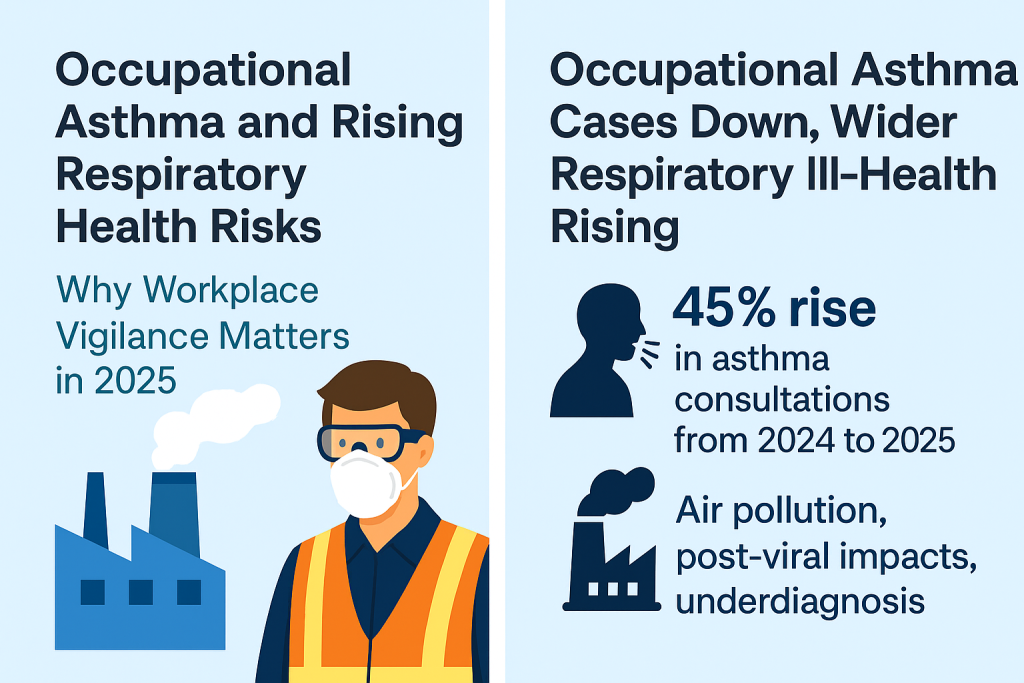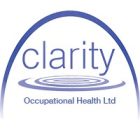Introduction:
Occupational asthma remains a key focus of workplace health surveillance. According to the Health and Safety Executive: “Since 2000 statistics indicate that there has been a decrease in the number of reported cases of occupational asthma.
The occupations with the highest incidence rates include bakers and vehicle paint sprayers.” (HSE, 2022)
While this downward trend may reflect improved control measures in some high risk sectors, it does not eliminate the need for clinical vigilance. The British Thoracic Society estimates that one in six cases of adult onset asthma are attributable to occupational causes. Dr Chris Barber, Chair of the BTS Clinical Statement Group, stresses the importance of early detection and intervention: “If spotted early enough, some patients can effectively be cured, if workplace adaptations can be made that completely prevent further exposure to the cause. Early referral to a specialist centre offers patients the best chance of a good outcome.” (British Thoracic Society, 2022)
Although this looks to be a broadly positive picture, it is not the full story. Against this backdrop, the wider respiratory health of the UK population appears to be under increasing pressure. Respiratory illness now accounts for nearly one in twelve days lost across the UK workforce, according to ONS data reported in Personnel Today.

In June 2025, the Royal College of General Practitioners reported a 45 percent rise in asthma related GP consultations in the first half of the year compared to 2024.
Pollution events, particularly elevated ozone levels during warmer months, were directly linked to this rise.
Meanwhile, data from the Office for National Statistics, cited in Personnel Today, shows that:
- Working days lost to respiratory conditions rose from 6.4 million in 2020 to 16.2 million in 2022
- This represents an increase from 5.5 percent to 8.7 percent of all lost workdays
In 2024, 24.1 percent of short term civil service absences were caused by respiratory illness, the single largest category. These are not marginal shifts. They reflect a growing and measurable burden on the respiratory health of the UK workforce.
In occupational health, spirometry is a core tool for identifying early signs of respiratory impairment. Where it is being conducted in accordance with COSHH requirements or other valid indications, the clinical results may be influenced by factors beyond the workplace.
For example:
- Air pollution, especially ozone and fine particulates, is associated with temporary but clinically significant reductions in FEV1 and FVC, potentially enough to drop borderline individuals below the Lower Limit of Normal
- Asthma exacerbations, even in mild or undiagnosed cases, can acutely affect lung function
- Long COVID and post viral breathlessness are linked to persistent breathlessness and functional impairment in a subset of individuals. These effects typically include mild reductions in expiratory flow and gas exchange rather than structural lung damage. In occupational health settings, such low grade impairments may be enough to cross LLN thresholds, particularly when combined with other stressors.
These factors may increase the likelihood that individuals with marginal exposure risks now fall below LLN. LLN based thresholds, typically used in UK occupational health, are designed to detect clinically significant changes even when values fall just outside the expected range.
As a result, subtle population level declines in lung function may now influence the outcomes seen in valid surveillance activity, not due to heightened workplace exposure, but due to reduced baseline resilience in the population.
Respiratory surveillance in occupational health typically includes a combination of health questionnaires and spirometry.
It is important to recognise that either route, reported symptoms or measurable reductions in lung function, may warrant further clinical investigation in its own right. For example, individuals recovering from post viral illness may present with persistent symptoms despite near normal spirometry. These cases should not be dismissed, as subtle dysfunction or heightened airway sensitivity may still be relevant and merit further assessment.
Occupational Health providers must also avoid the trap of dismissing respiratory symptoms on the assumption that they are solely related to an existing or known diagnosis. This risks overlooking the onset of a new occupational condition, or a workplace related exacerbation of an existing one. Thorough assessment remains essential to distinguish environmental or lifestyle influences from potential work related contributors.
This is why it remains critical that all abnormal findings, whether symptom driven or spirometry based, are assessed in context.
Investigating each case properly avoids false reassurance and ensures that genuine work related respiratory issues are not missed at an early stage.
Conducting health surveillance at appropriate intervals and acting on the findings is not just a legal requirement, but the ethical thing to do. Occupational health will be able to rule out occupational asthma to provide you with reassurance that your control measures are effective. In the unfortunate scenarios where there is potential work related disease, timely follow ups allow for quicker diagnosis, improve prognosis, and allow wider protection of the workforce by driving a review of control measures.
Air quality, post COVID impacts, and under diagnosed asthma may all be contributing to greater baseline impairment in the population. Where spirometry is already indicated, these population level pressures may now influence the clinical outcomes seen in routine surveillance.
Where this leads is not yet clear. But what is clear is that workplace surveillance remains a key tool for understanding early health change and building interventions that support long term workforce resilience. Employers and occupational health providers should not become complacent if they experience an increase in respiratory referrals. Broader UK trends may be influencing results, but this does not remove the responsibility to fully investigate each case and continue to guard against potential work related disease.
Sources:
RCGP: https://www.rcgp.org.uk/news/asthma-attacks-rise-dramatically
Personnel Today: https://www.personneltoday.com/hr/working-days-lost-to-asthma-up-tenfold-since-pandemic
HSE: https://www.hse.gov.uk/asthma/about.htm
This article was written and published by Andrew Cooke – Operations Director at Clarity Occupational Health







